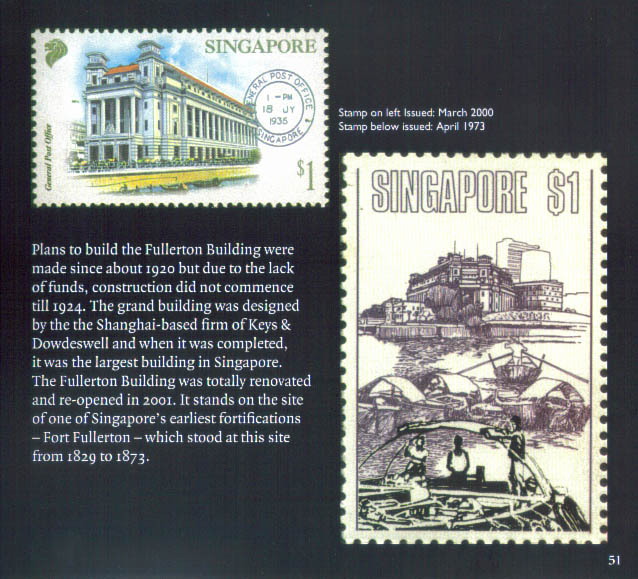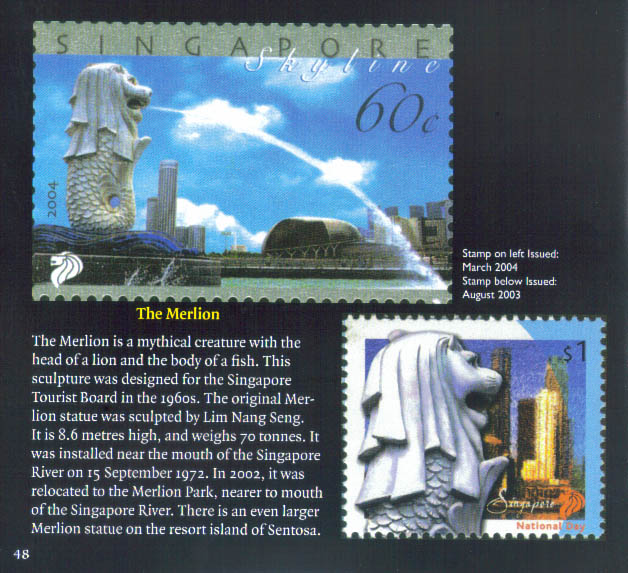Archive for January 2010
Page 54

The Singapore River
Water is essential to life and life around a river marks the beginning of a community. For Singapore, the river was the Singapore River. This landmark river features prominently in many stamps. Among the landmarks and monuments shown on our stamps, the Singapore River has been featured the most times.
The Singapore River was a hive of activity for cargo-laden barges for more than a century. Today this river is now a placid waterway for tourist boats.
In June 2000 a special set of stamps entitled ‘Singapore River: Reflecting on a Century’ was issued (see next page spread).
The earliest stamp of the Singapore River appeared in 1955. The picture of Queen Elizabeth II on the $2 stamp shows that Singapore, and Malaya (now known as West Malaysia), was still under British control at that time.
Among the Singapore River stamps shown here are scenes of river life (next page) painted by three famous artists; Georgette Chen (top right), Poh Siew Wah (bottom left) and Lee Boon Wang (bottom right).
Page 53

Telok Ayer Market
Some landmarks have stayed true to its original purpose. An example is the Telok Ayer Market near Raffles Place. Popularly known as ‘Lau Pa Sat’ (the Old Market), it was built in 1894. Situated in the heart of the Central Business District, Telok Ayer Market still sells food today, although most of the food is cooked. It is a popular food centre catering to both locals and tourists.
The watercolour picture of Telok Ayer Market shown on the 2004 stamp was painted by Ong Kim Seng, who was awarded the Singapore Cultural Medallion in 1990. The Telok Ayer Market was gazetted as a National Monument on 6 July 1973.
Page 52

Singapore Post Centre
Singapore’s postal history is a rich one and the buildings that housed its main post office were some of the most important and outstanding in their time.
The building depicted on the stamp on the left is the Post Office and Exchange Building which stood on the site of what is now the Fullerton Hotel. The Post Office was originally located near Empress Place but moved to this site in 1874. This building was designed by William Daniel Bayliss and opened in 1879 and remained the home of the Post Office till 1924 when it was demolished to make way for the Fullerton Building.
Singapore’s current postal headquarters is the Singapore Post Centre (SPC) in Paya Lebar. Besides being the corporate headquarters of Singapore Post, this futuristic-looking Centre has shops, restaurants and a supermarket to cater for non-postal needs.
Page 51

Plans to build the Fullerton Building were made since about 1920 but due to the lack of funds, construction did not commence till 1924. The grand building was designed by the Shanghai-based firm of Keys & Dowdeswell and when it was completed, it was the largest building in Singapore. The Fullerton Building was totally renovated and re-opened in 2001. It stands on the site of one of Singapore’s earliest fortifications – Fort Fullerton – which stood at this site from 1829 to 1873.
Page 50

Fullerton Building
This red-roofed building was completed in 1928 and named after Robert Fullerton, first Governor of the Straits Settlements. It sits on the site of an earlier General Post Office (see next page) which was torn down to make way for the larger building.
Located at the mouth of the Singapore River, the Fullerton Building also housed various government offices. The General Post Office (GPO) was located in that building up to 1996. It was then totally renovated and is now the elegant five-star Fullerton Hotel. In its early years, the Fullerton Building dominated the Singapore skyline. Today it is dwarfed by its surrounding skyscrapers.
Page 49

Raffles Hotel
Raffles Hotel was the brainchild of four visionary Armenian brothers: Martin, Tigran, Aviet and Arshak Sarkies. The Sarkies brothers were well-known hoteliers having earlier opened the Eastern & Oriental Hotel in Penang and The Strand Hotel in Rangoon.
The Hotel opened in 1887 and was originally housed in a sombre-looking old bungalow known as the Beach House. It was later renamed Raffles Hotel, after Singapore’s founder. One of its earliest guests was the famous novelist Joseph Conrad.
The main building of Raffles Hotel as we know it today was opened in 1899. Over the years, the hotel played host to numerous celebrities including Somerset Maugham, Rudyard Kipling, Charles Chaplin and Noel Coward.
The main building was gazetted as a National Monument in 1987. Thereafter, the hotel underwent massive renovations and a whole new wing on North Bridge Road was added. It reopened in 1991 to great acclaim and retains its status as Singapore’s premier address.
The Raffles Hotel is world-famous for one other thing: The Singapore Sling. The drink was created by Ngiam Tong Boon for the Raffles Hotel Bar sometime in 1910s. It was also reputed that a tiger was shot under the billiard table at the Bar & Billiard Room in 1902.
Page 48

The Merlion
The Merlion is mythical creature with the head of a lion and the body of a fish. This sculpture was designed for the Singapore Tourist Board in the 1960s. The original Merlion statue was sculpted by Lim Nang Seng. It is 8.6 metres high, and weighs 70 tonnes. It was installed near the mouth of the Singapore River on 15 September 1972. In 2002, it was relocated to the Merlion Park, nearer to mouth of the Singapore River. There is an even larger Merlion statue on the resort island of Sentosa.
Page 47

Raffles Place
Located off the Singapore River is Raffles Place, which has always been connected with trade and commerce. In the early days, it was known as Commercial Square. In 1858, the square was renamed Raffles Place. The stamp shows a painting of what Raffles Place looked like in 1905. The horse carriage and the jinriksha were the popular modes of transport at that time.
In modern day Raffles Place there is a MRT train station underground. Above ground are many skyscrapers. These skyscrapers house the headquarters of many well-known banks and international companies which have made Singapore an important centre of finance and commerce. When the British founded Singapore, they developed the city and administrative centre around the Singapore River. In this present era, the major government buildings are still located near the river.